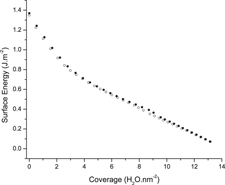Crossref Citations
This article has been cited by the following publications. This list is generated based on data provided by
Crossref.
Wu, Longjia
Dey, Sanchita
Gong, Mingming
Liu, Feng
and
Castro, Ricardo H. R.
2014.
Surface Segregation on Manganese Doped Ceria Nanoparticles and Relationship with Nanostability.
The Journal of Physical Chemistry C,
Vol. 118,
Issue. 51,
p.
30187.
Chang, Chi-Hsiu
Gong, Mingming
Dey, Sanchita
Liu, Feng
and
Castro, Ricardo H. R.
2015.
Thermodynamic Stability of SnO2Nanoparticles: The Role of Interface Energies and Dopants.
The Journal of Physical Chemistry C,
Vol. 119,
Issue. 11,
p.
6389.
Jin, Hongyun
Ji, Zhengjia
Yuan, Jiao
Li, Ji
Liu, Min
Xu, Chunhui
Dong, Jie
Hou, Pan
and
Hou, Shuen
2015.
Research on removal of fluoride in aqueous solution by alumina-modified expanded graphite composite.
Journal of Alloys and Compounds,
Vol. 620,
Issue. ,
p.
361.
Dargatz, Benjamin
Gonzalez-Julian, Jesus
Bram, Martin
Jakes, Peter
Besmehn, Astrid
Schade, Lisa
Röder, Robert
Ronning, Carsten
and
Guillon, Olivier
2016.
FAST/SPS sintering of nanocrystalline zinc oxide—Part I: Enhanced densification and formation of hydrogen-related defects in presence of adsorbed water.
Journal of the European Ceramic Society,
Vol. 36,
Issue. 5,
p.
1207.
Castro, Ricardo H. R.
Gouvêa, Douglas
and
Wakai, F.
2016.
Sintering and Nanostability: The Thermodynamic Perspective.
Journal of the American Ceramic Society,
Vol. 99,
Issue. 4,
p.
1105.
Miagava, Joice
da Silva, Andre L.
Navrotsky, Alexandra
Castro, Ricardo H.R.
Gouvêa, Douglas
and
Rohrer, G.
2016.
The Nanocrystalline SnO2–TiO2 System‒Part II: Surface Energies and Thermodynamic Stability.
Journal of the American Ceramic Society,
Vol. 99,
Issue. 2,
p.
638.
Dargatz, Benjamin
Gonzalez-Julian, Jesus
Bram, Martin
Shinoda, Yutaka
Wakai, Fumihiro
and
Guillon, Olivier
2016.
FAST/SPS sintering of nanocrystalline zinc oxide—Part II: Abnormal grain growth, texture and grain anisotropy.
Journal of the European Ceramic Society,
Vol. 36,
Issue. 5,
p.
1221.
Hasan, Md M.
Dey, Sanchita
Nafsin, Nazia
Mardinly, John
Dholabhai, Pratik P.
Uberuaga, Blas P.
and
Castro, Ricardo H. R.
2016.
Improving the Thermodynamic Stability of Aluminate Spinel Nanoparticles with Rare Earths.
Chemistry of Materials,
Vol. 28,
Issue. 14,
p.
5163.
Sharma, Geetu
and
Castro, Ricardo H.R.
2017.
Synthesis and surface enthalpy of MgGa2O4 spinel.
Thermochimica Acta,
Vol. 655,
Issue. ,
p.
326.
Pereira, Gilberto J.
Bolis, Karen
Muche, Dereck N.F.
Gouvêa, Douglas
and
Castro, Ricardo H.R.
2017.
Direct measurement of interface energies of magnesium aluminate spinel and a brief sintering analysis.
Journal of the European Ceramic Society,
Vol. 37,
Issue. 13,
p.
4051.
Gong, M.M.
Dey, S.
Wu, L.J.
Chang, C.H.
Li, H.
Castro, R.H.R.
and
Liu, F.
2017.
Effects of concurrent grain boundary and surface segregation on the final stage of sintering: the case of Lanthanum doped yttria-stabilized zirconia.
Journal of Materials Science & Technology,
Vol. 33,
Issue. 3,
p.
251.
Gonzalez-Julian, J.
Neuhaus, K.
Bernemann, M.
Pereira da Silva, J.
Laptev, A.
Bram, M.
and
Guillon, O.
2018.
Unveiling the mechanisms of cold sintering of ZnO at 250 °C by varying applied stress and characterizing grain boundaries by Kelvin Probe Force Microscopy.
Acta Materialia,
Vol. 144,
Issue. ,
p.
116.
Yang, Chenguang
Zhu, Weidi
Sen, Sabyasachi
and
Castro, Ricardo H. R.
2019.
Site Inversion Induces Thermodynamic Stability against Coarsening in Zinc Aluminate Spinel.
The Journal of Physical Chemistry C,
Vol. 123,
Issue. 14,
p.
8818.
Sharma, Geetu
Nakajima, Kimiko
Muche, Dereck N.F.
and
Castro, Ricardo H.R.
2020.
The influence of dopants on the surface enthalpy of Yttrium aluminum garnet (YAG).
Thermochimica Acta,
Vol. 683,
Issue. ,
p.
178471.
Mordekovitz, Y.
Shelly, L.
and
Hayun, S.
2021.
Interactions of water vapor and carbon dioxide with Ca doped ceria surfaces.
Ceramics International,
Vol. 47,
Issue. 2,
p.
2483.
Castro, Ricardo H.R.
2021.
Interfacial energies in nanocrystalline complex oxides.
Current Opinion in Solid State and Materials Science,
Vol. 25,
Issue. 3,
p.
100911.
Kreisberg, Valery A.
2021.
Degassing and diffusion characteristics of Eu-doped gahnite ZnAl2O4 by kinetic thermodesorption mass spectrometry.
Journal of Alloys and Compounds,
Vol. 887,
Issue. ,
p.
161258.
Nadjafi, Manouchehr
Kierzkowska, Agnieszka M.
Armutlulu, Andac
Verel, Rene
Fedorov, Alexey
Abdala, Paula M.
and
Müller, Christoph R.
2021.
Correlating the Structural Evolution of ZnO/Al2O3 to Spinel Zinc Aluminate with its Catalytic Performance in Propane Dehydrogenation.
The Journal of Physical Chemistry C,
Vol. 125,
Issue. 25,
p.
14065.
Mordekovitz, Yuval
Shelly, Lee
Rosen, Brian A.
and
Hayun, Shmuel
2021.
Surface properties of Ca, Ti‐doped CeO2 and their influence on the reverse water‐gas shift reaction.
Journal of the American Ceramic Society,
Vol. 104,
Issue. 5,
p.
2337.
Krishna, B. Gopal
Tiwari, Sanjay
Ghosh, Dhriti Sundar
and
Rao, M. Jagannadha
2023.
Adsorption through Advanced Nanoscale Materials.
p.
343.
